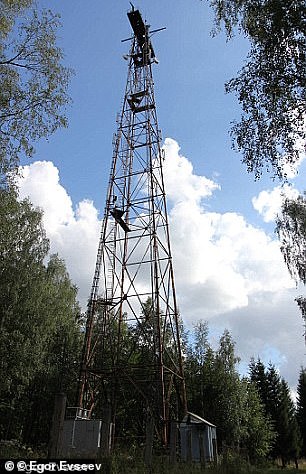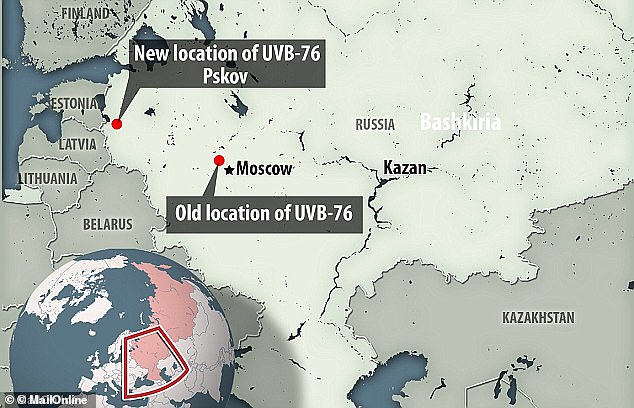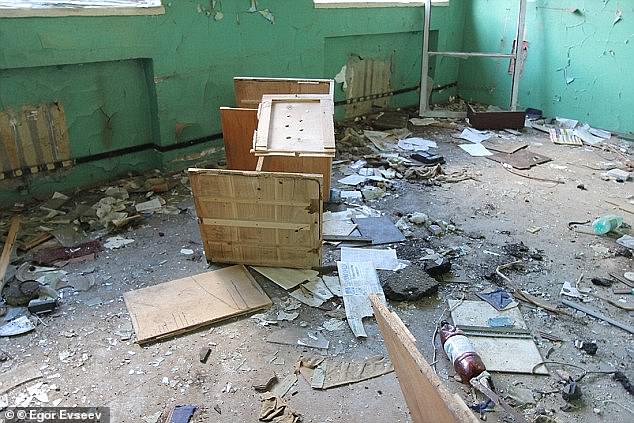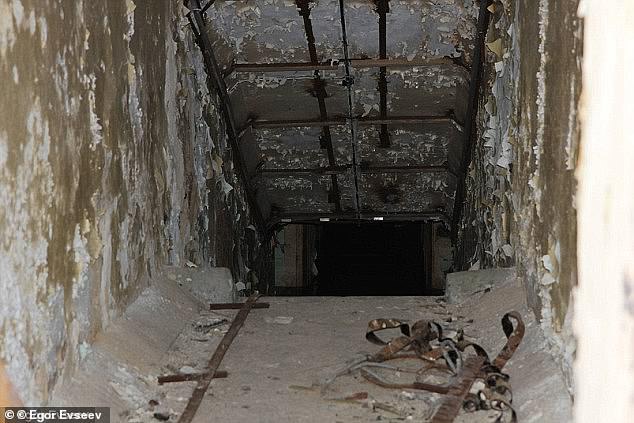Mysterious Russian radio signal that has been broadcasting for 40 years baffles scientists – amid alleged links to UFOs and nuclear weapons
For four decades, since the height of the Cold War, a mysterious radio signal has been broadcast from Russia, baffling ham radio fans, scientists and spies alike.
Some speculate that it is part of the Russian government’s secret SETI program or even actively communicating with a visiting alien species.
Others believe it could be a doomsday scenario, ready to launch nuclear weapons if Russia’s leadership is knocked out.
But according to a professor of electronics and radio engineering who has studied the signal, one thing is certain: “It is almost certain that the Russian government is using it,” he said.
And: ‘If it’s the Russian government, it wouldn’t be for peaceful purposes.’

For four decades, since the height of the Cold War, a mysterious radio signal has been broadcast from Russia – example signal at left – baffling amateur radio fans, scientists and spies alike. Top right one of the towers transmitting the signal, 30 kilometers outside Moscow
Professor David Stuppelswho teaches electronic and radio engineering at the City University of London, personally believes that the enigmatic broadcast, nicknamed ‘The Buzzer’, was probably kept active as a fail-safe in the event of nuclear war.
Broadcast on the shortwave radio frequency of 4625 kHz, the Buzzer has led Some physicists speculate that its signal is used to monitor Earth’s ionosphere.
But Professor Stupples – whose expertise is in orbital or otherwise space-based exploration platforms, surveillance and navigation systems – acknowledges that explanations both unbelievable and mundane are all still on the table.
“Maybe they’re just reserving the canal for air defense or some other form of defense,” Stupples said Popular mechanics this week.
“If they don’t actually use it, someone will poach it,” Stupples said. “They keep the channel available by broadcasting and saying, ‘This is ours.’

In 2010, the source point of the UVB-76 broadcast shifted, surrounded by strange occurrences and new oddities in the seemingly random tones, voices and information – which it has broadcast continuously since the 1970s.
Interest in amateur ham radios and unclassified scientific interest in ‘The Buzzer’, officially known by its original call sign ‘UVB-76’, first peaked in 1982.
At the time, the station was known to transmit only a coded and baffling series of beeps, but in 1992 the transmissions became stranger: a series of buzzing sounds, 25 times per minute, each less than a second, and the occasional ominous foghorn.
In the 1990s, the UVB-76’s hum was also sporadically interrupted by anonymous male and female voices reading lists of seemingly random names, words or numbers.
The tones of the sounds the station broadcast would also vary, possibly with secret information packed into those tonal shifts.
This diversity of strange transmissions is what caught the attention of Professor Stupples and other researchers, because that diversity does not fit a simple ’emergency placeholder’ signal.
According to the surveillance engineering expert, a government or military institution that simply wants to maintain control of a particular radio frequency will typically transmit only a single basic test pattern over and over again.
Not only does the UVB-76 ‘Buzzer’ instead emit more complex and confusing signals, but also more powerful, transferring more than many thousands of watts of energy, based on Professor Stupples’ measurements, and in all directions.
“I ran it through my signal spectrum analyzers,” Stupples said, “and I can’t get any intelligence out of it at all.”

A Russian student from Canada, Egor Esveev, tracked down the mysterious broadcast to an apparently abandoned Russian base near Pskov, on the border with Estonia. Esveev told MailOnline.com in 2014 that he found the abandoned location very creepy
Fradio monitor Ary Boender from the Netherlands, who runs the website Numbers Oddities, has heard and considered many theories about the signal over the years.
“Some say it’s an old Soviet Dead Man’s Switch that triggers a nuclear attack on the West when it stops buzzing,” she explained.
“Others say it’s a beacon for UFOs,” Boender continued, “or a mind control device that allows the Russians to program your mind.”
“In the past it was said to be a remote control station of the Chernobyl nuclear power plant,” she recalls.
Jochen Schäfer, who for years headed a civilian group in Germany that spied on professional spies, once claimed that the Buzzer is a numbers station: a radio broadcast that allows agents in the field to send coded messages.
“It’s not a typical numbers station, but it is one,” Schäfer emphasized Wired in 2011.
According to Stupples, all of these theories, even the most bizarre ones, could still prove true to this day.
“It’s always entertaining, isn’t it?” Stupples told Popular Mechanics. “And you never know, maybe one of those crazy views will be right, and we’ll all have a simple pie.”
But the mystery of UVB-76 deepened in 2010, when it disappeared from its first broadcast location, which had been tracked to a Russian army base near the town of Povarovo, 30 kilometers outside Moscow.

Most of the buildings, some semi-underground, have been destroyed or abandoned, according to Mr Evseev, while cables have been visibly torn from the ground in some areas

“We found tons of rubbish documents,” Evseev added. “One we found, interestingly enough, was about ceasing operations of the base.”
The signal stopped transmitting for about 24 hours.
When it returned, strange pauses began appearing in the broadcast, and on August 25, 2010, amateur listeners eavesdropping on the station heard what they described as people shuffling around a room.
Some of these strange new transmissions resembled Morse code.
Then, one day, the channel started airing excerpts from composer Tchaikovsky’s ballet “Swan Lake,” and the call sign changed from “UVB-76” to “MDZhB,” spoken by a mysterious figure called “Mikhail Dumitri Zhengya Boris.” said.
The station also once broadcast a time signal, sounding a one-minute buzzer with two melodies at the top of each hour. This was disabled in June 2010 and no time signal has been replaced.
Interestingly, codes have also been repeated over months or years, for unknown reasons. On January 26, 2011, the operator read out ‘ILOTICIN 36 19 69 46’. This was repeated almost four months later on May 11, 2011.
Russian student Egor Esveev, 20, who is originally from Moscow but now studies in Ottawa, told MailOnline in 2014 that he managed to trace the origin of the signal after it moved from Povarovo.
Esveev said he found it near Pskov, on the border with Estonia, which he explored and photographed himself.
“Like any abandoned building or area, it was very creepy,” he told MailOnline in 2014.
‘Strange people and a very strange landscape.’
Esveev said he encountered “a woman in her mid-forties” pushing “a stroller.”
“At first I thought she was a local resident out for a walk, but as she walked past I noticed her stroller was empty,” he said.
“Who goes walking to an abandoned military base with an empty stroller?”
He said the station was set up as a “typical Russian military base” with two different perimeters.
Most of the buildings, some semi-underground, were destroyed or abandoned, according to Mr Evseev, while cables were visibly torn from the ground in some areas.
“We found tons of rubbish documents,” he added. “One we found, interestingly enough, was about shutting down base operations.”
Esveev said he believes the station could be used for some form of internal communication that, “while secret, is not sensitive enough to mask or keep secret.”
But no matter how hard people try to investigate the mystery of the Russian 4625kHz signal, according to Professor Stupples, the British electronic and radio engineer, definitive conclusions are likely to remain just out of reach without any official confirmation.
“I think in order to find the whole truth – and nothing but the truth – I think it has to come from the Russian Federation itself,” Stupples said.
